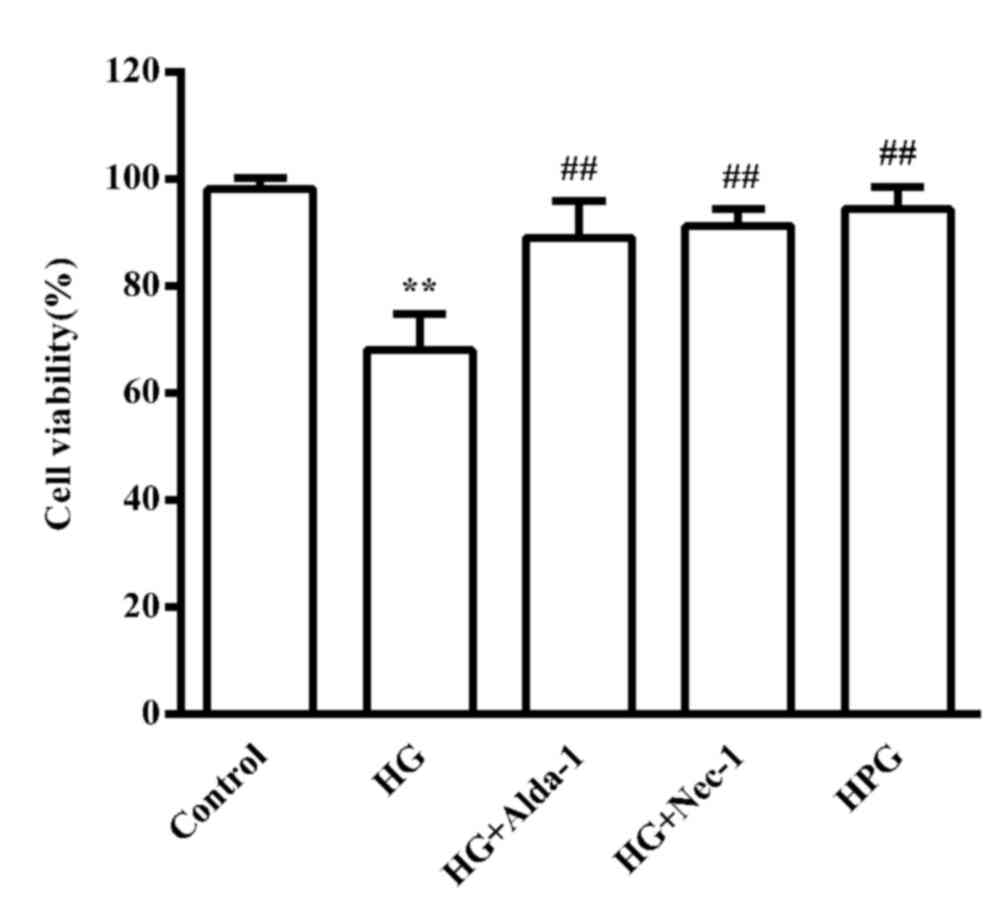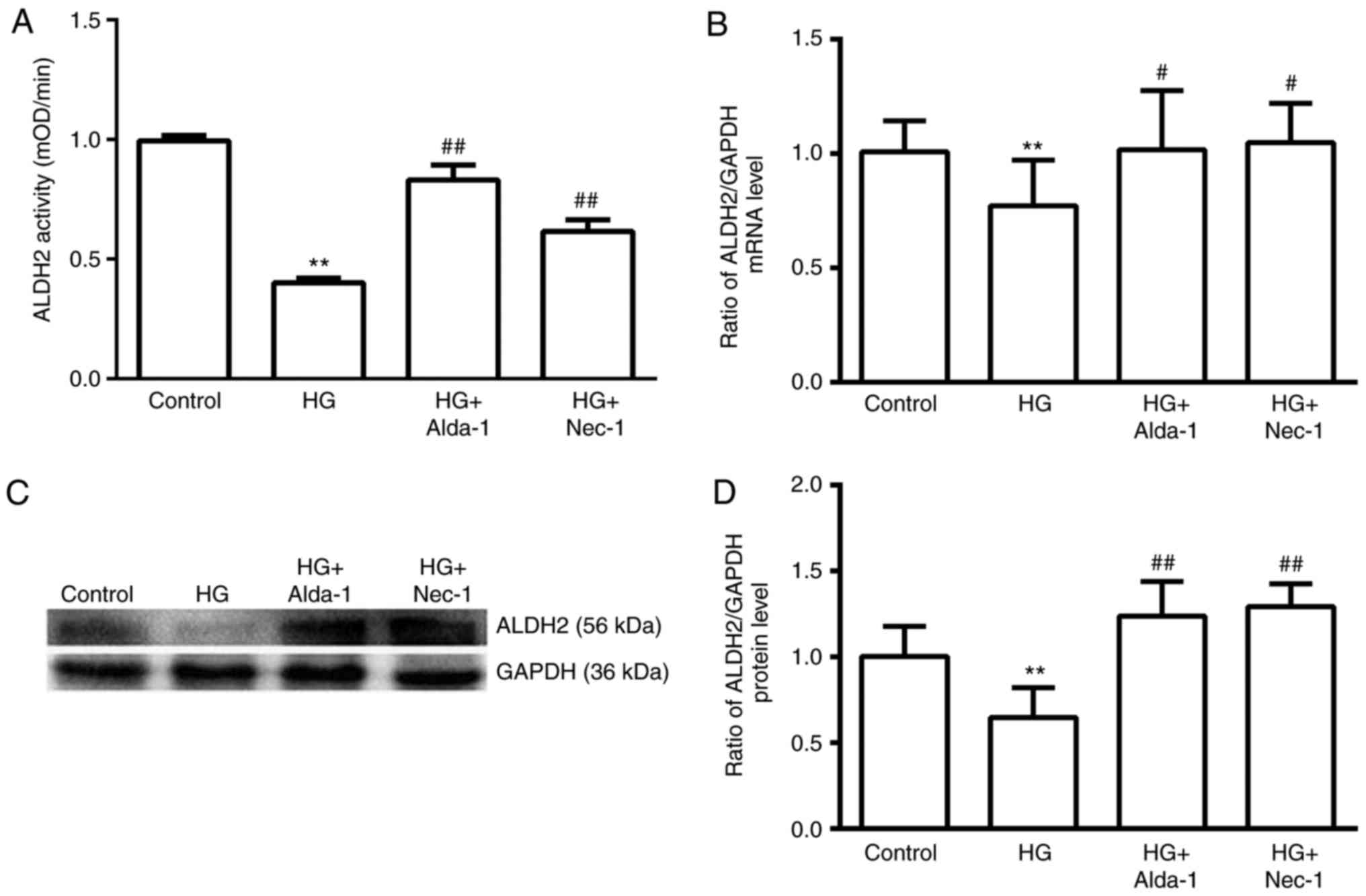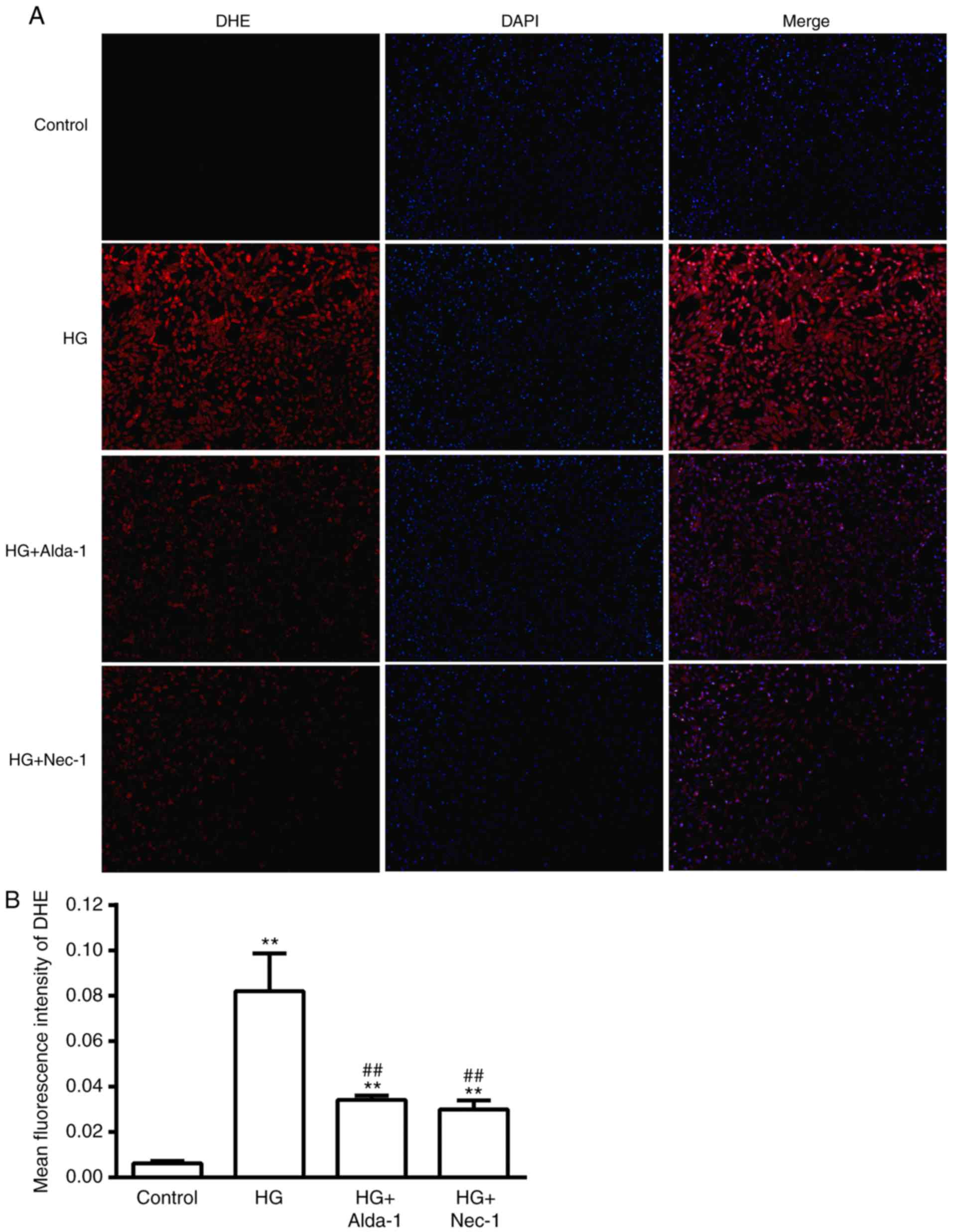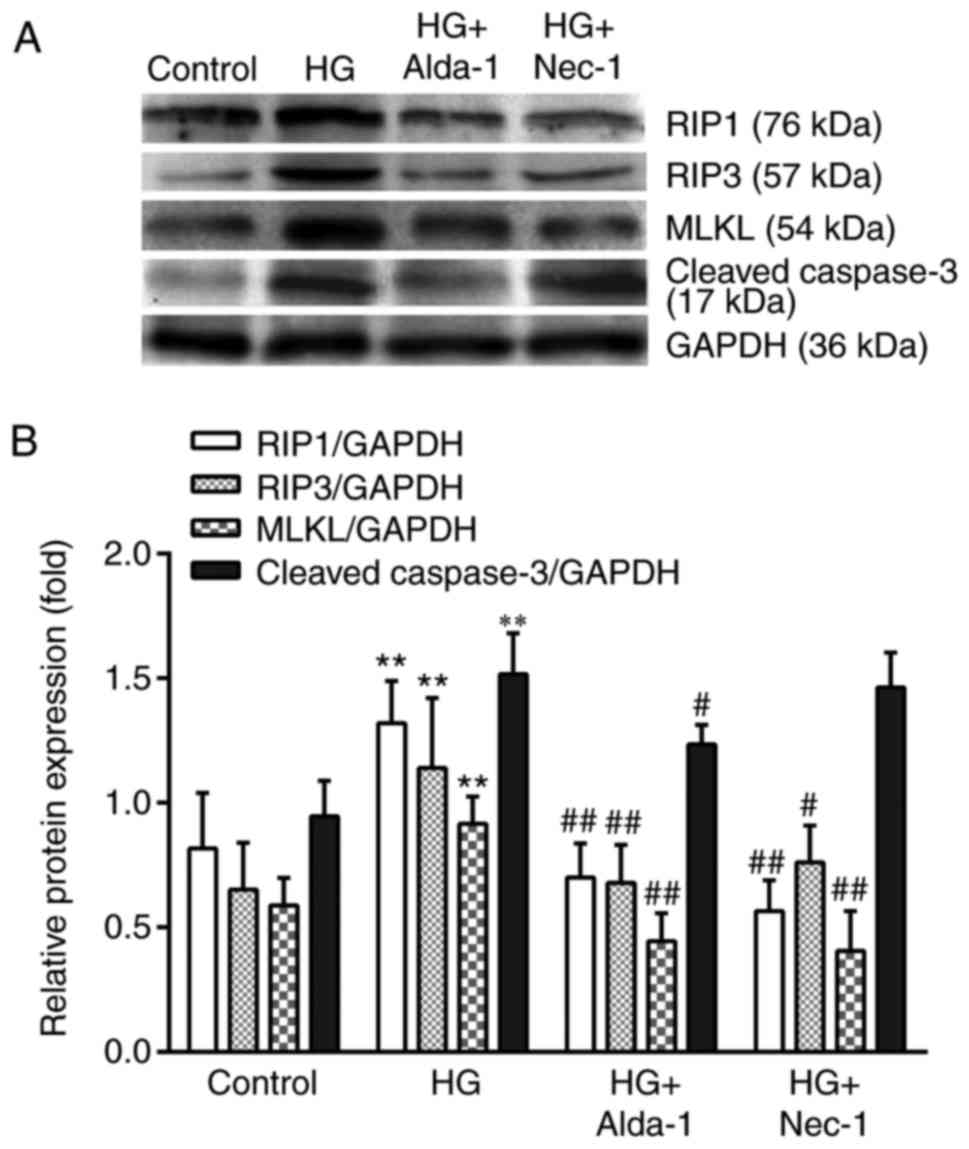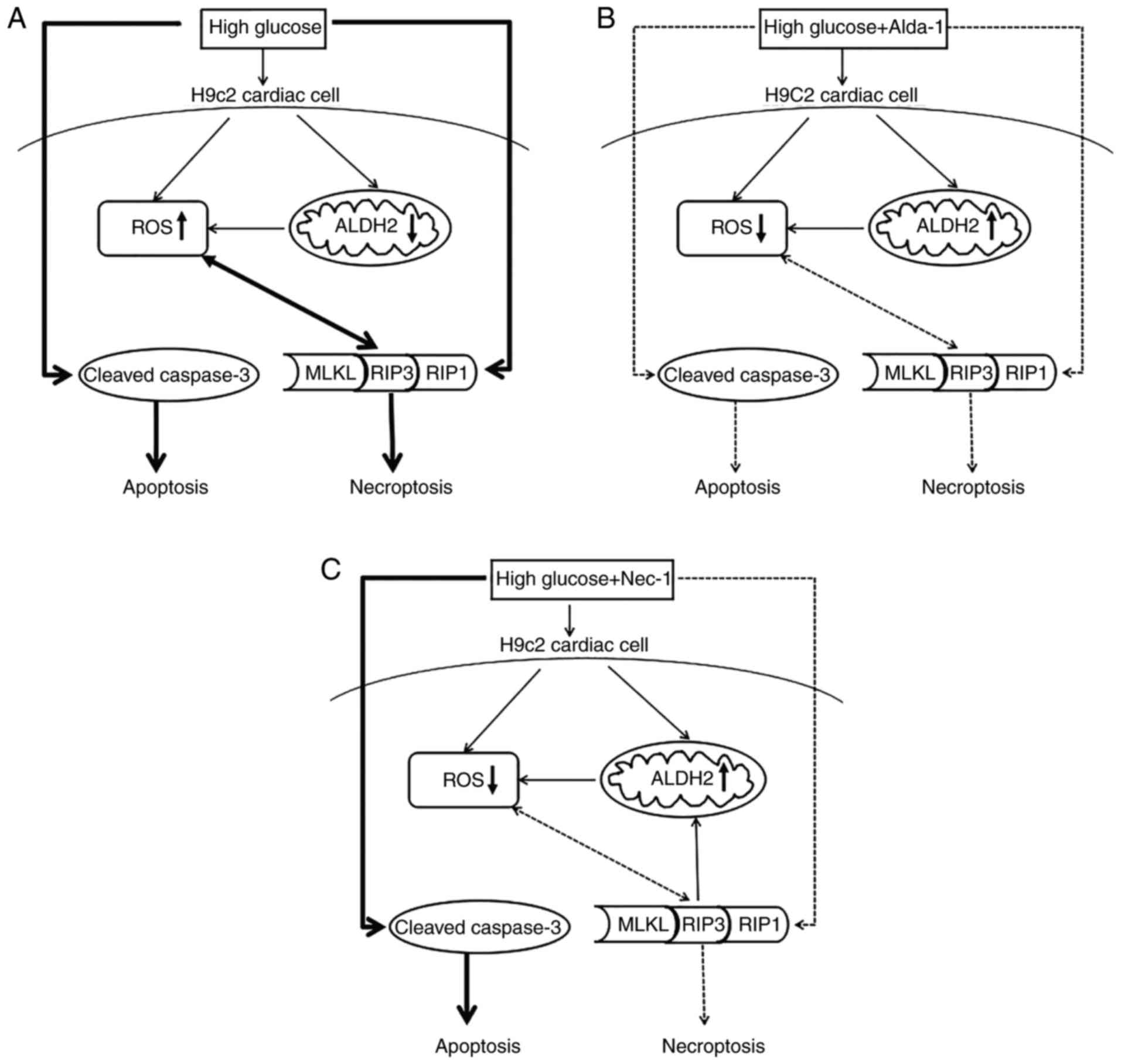|
1
|
Arora D, Sharma PK, Siddiqui MH and Shukla
Y: Necroptosis: Modules and molecular switches with therapeutic
implications. Biochimie. 137:35–45. 2017. View Article : Google Scholar : PubMed/NCBI
|
|
2
|
Weinlich R, Oberst A, Beere HM and Green
DR: Necroptosis in development, inflammation and disease. Nat Rev
Mol Cell Biol. 18:127–136. 2017. View Article : Google Scholar : PubMed/NCBI
|
|
3
|
Liang W, Chen M, Zheng D, He J, Song M, Mo
L, Feng J and Lan J: A novel damage mechanism: Contribution of the
interaction between necroptosis and ROS to high glucose-induced
injury and inflammation in H9c2 cardiac cells. Int J Mol Med.
40:201–208. 2017. View Article : Google Scholar : PubMed/NCBI
|
|
4
|
Liang W, Chen M, Zheng D, Li J, Song M,
Zhang W, Feng J and Lan J: The opening of ATP-sensitive K+ channels
protects H9c2 cardiac cells against the high glucose-induced injury
and inflammation by inhibiting the ROS-TLR4-necroptosis pathway.
Cell Physiol Biochem. 41:1020–1034. 2017. View Article : Google Scholar : PubMed/NCBI
|
|
5
|
Luo XJ, Liu B, Ma QL and Peng J:
Mitochondrial aldehyde dehydrogenase, a potential drug target for
protection of heart and brain from ischemia/reperfusion injury.
Curr Drug Targets. 15:948–955. 2014.PubMed/NCBI
|
|
6
|
Matsumoto A, Thompson DC, Chen Y, Kitagawa
K and Vasiliou V: Roles of defective ALDH2 polymorphism on liver
protection and cancer development. Environ Health Prev Med.
21:395–402. 2016. View Article : Google Scholar : PubMed/NCBI
|
|
7
|
Gao Q, Wang HJ, Wang XM, Kang PF, Yu Y, Ye
HW, Zhou H and Li ZH: Activation of ALDH2 with ethanol attenuates
diabetes induced myocardial injury in rats. Food Chem Toxicol.
56:419–424. 2013. View Article : Google Scholar : PubMed/NCBI
|
|
8
|
Kang PF, Wu WJ, Tang Y, Xuan L, Guan SD,
Tang B, Zhang H, Gao Q and Wang HJ: Activation of ALDH2 with low
concentration of ethanol attenuates myocardial ischemia/reperfusion
injury in diabetes rat model. Oxid Med Cell Longev.
2016:61905042016. View Article : Google Scholar : PubMed/NCBI
|
|
9
|
Guo Y, Yu W, Sun D, Wang J, Li C, Zhang R,
Babcock SA, Li Y, Liu M, Ma M, et al: A novel protective mechanism
for mitochondrial aldehyde dehydrogenase (ALDH2) in type i
diabetes-induced cardiac dysfunction: Role of AMPK-regulated
autophagy. Biochim Biophys Acta. 1852:319–331. 2015. View Article : Google Scholar : PubMed/NCBI
|
|
10
|
Livak KJ and Schmittgen TD: Analysis of
relative gene expression data using real-time quantitative PCR and
the 2(-Delta Delta C(T)) method. Methods. 25:402–408. 2001.
View Article : Google Scholar : PubMed/NCBI
|
|
11
|
Fuchs Y and Steller H: Live to die another
way: Modes of programmed cell death and the signals emanating from
dying cells. Nat Rev Mol Cell Biol. 16:329–344. 2015. View Article : Google Scholar : PubMed/NCBI
|
|
12
|
Sun L, Wang H, Wang Z, He S, Chen S, Liao
D, Wang L, Yan J, Liu W, Lei X and Wang X: Mixed lineage kinase
domain-like protein mediates necrosis signaling downstream of RIP3
kinase. Cell. 148:213–227. 2012. View Article : Google Scholar : PubMed/NCBI
|
|
13
|
Wu W, Liu P and Li J: Necroptosis: An
emerging form of programmed cell death. Crit Rev Oncol Hematol.
82:249–258. 2012. View Article : Google Scholar : PubMed/NCBI
|
|
14
|
Cano M, Wang L, Wan J, Barnett BP,
Ebrahimi K, Qian J and Handa JT: Oxidative stress induces
mitochondrial dysfunction and a protective unfolded protein
response in RPE cells. Free Radic Biol Med. 69:1–14. 2014.
View Article : Google Scholar : PubMed/NCBI
|
|
15
|
Osipov RM, Bianchi C, Feng J, Clements RT,
Liu Y, Robich MP, Glazer HP, Sodha NR and Sellke FW: Effect of
hypercholesterolemia on myocardial necrosis and apoptosis in the
setting of ischemia-reperfusion. Circulation. 120 11 Suppl:S22–S30.
2009. View Article : Google Scholar : PubMed/NCBI
|
|
16
|
Zhang DW, Shao J, Lin J, Zhang N, Lu BJ,
Lin SC, Dong MQ and Han J: RIP3, an energy metabolism regulator
that switches TNF-induced cell death from apoptosis to necrosis.
Science. 325:332–336. 2009. View Article : Google Scholar : PubMed/NCBI
|
|
17
|
LaRocca TJ, Sosunov SA, Shakerley NL, Ten
VS and Ratner AJ: Hyperglycemic conditions prime cells for
RIP1-dependent necroptosis. J Biol Chem. 291:13753–13761. 2016.
View Article : Google Scholar : PubMed/NCBI
|
|
18
|
Wang X, Yousefi S and Simon HU:
Necroptosis and neutrophil-associated disorders. Cell Death Dis.
9:1112018. View Article : Google Scholar : PubMed/NCBI
|
|
19
|
Chen CH, Joshi AU and Mochly-Rosen D: The
role of mitochondrial aldehyde dehydrogenase 2 (ALDH2) in
neuropathology and neurodegeneration. Acta Neurol Taiwan.
25:111–123. 2016.PubMed/NCBI
|
|
20
|
Lao-Sirieix P, Caldas C and Fitzgerald RC:
Genetic predisposition to gastro-oesophageal cancer. Curr Opin
Genet Dev. 20:210–217. 2010. View Article : Google Scholar : PubMed/NCBI
|
|
21
|
Wang J, Wang H, Hao P, Xue L, Wei S, Zhang
Y and Chen Y: Inhibition of aldehyde dehydrogenase 2 by oxidative
stress is associated with cardiac dysfunction in diabetic rats. Mol
Med. 17:172–179. 2011. View Article : Google Scholar : PubMed/NCBI
|
|
22
|
Degterev A, Huang Z, Boyce M, Li Y, Jagtap
P, Mizushima N, Cuny GD, Mitchison TJ, Moskowitz MA and Yuan J:
Chemical inhibitor of nonapoptotic cell death with therapeutic
potential for ischemic brain injury. Nat Chem Biol. 1:112–119.
2005. View Article : Google Scholar : PubMed/NCBI
|
|
23
|
Adameova A, Hrdlicka J, Szobi A, Farkasova
V, Kopaskova K, Murarikova M, Neckar J, Kolar F, Ravingerova T and
Dhalla NS: Evidence of necroptosis in hearts subjected to various
forms of ischemic insults. Can J Physiol Pharmacol. 95:1163–1169.
2017. View Article : Google Scholar : PubMed/NCBI
|
|
24
|
Vieira M, Fernandes J, Carreto L,
Anuncibay-Soto B, Santos M, Han J, Fernández-López A, Duarte CB,
Carvalho AL and Santos AE: Ischemic insults induce necroptotic cell
death in hippocampal neurons through the up-regulation of
endogenous RIP3. Neurobiol Dis. 68:26–36. 2014. View Article : Google Scholar : PubMed/NCBI
|
|
25
|
Oerlemans MI, Koudstaal S, Chamuleau SA,
de Kleijn DP, Doevendans PA and Sluijter JP: Targeting cell death
in the reperfused heart: Pharmacological approaches for
cardioprotection. Int J Cardiol. 165:410–422. 2013. View Article : Google Scholar : PubMed/NCBI
|
|
26
|
Shen C, Wang C, Han S, Wang Z, Dong Z,
Zhao X, Wang P, Zhu H, Sun X, Ma X, et al: Aldehyde dehydrogenase 2
deficiency negates chronic low-to-moderate alcohol
consumption-induced cardioprotecion possibly via ROS-dependent
apoptosis and RIP1/RIP3/MLKL-mediated necroptosis. Biochim Biophys
Acta. 1863:1912–1918. 2017. View Article : Google Scholar : PubMed/NCBI
|
|
27
|
Liu M, Wu W, Li H, Li S, Huang LT, Yang
YQ, Sun Q, Wang CX, Yu Z and Hang CH: Necroptosis, a novel type of
programmed cell death, contributes to early neural cells damage
after spinal cord injury in adult mice. J Spinal Cord Med.
38:745–753. 2015. View Article : Google Scholar : PubMed/NCBI
|
|
28
|
Chang P, Dong W, Zhang M, Wang Z, Wang Y,
Wang T, Gao Y, Meng H, Luo B, Luo C, et al: Anti-necroptosis
chemical necrostatin-1 can also suppress apoptotic and autophagic
pathway to exert neuroprotective effect in mice intracerebral
hemorrhage model. J Mol Neurosci. 52:242–249. 2014. View Article : Google Scholar : PubMed/NCBI
|
|
29
|
Liu ZM, Chen QX, Chen ZB, Tian DF, Li MC,
Wang JM, Wang L, Liu BH, Zhang SQ, Li F, et al: RIP3 deficiency
protects against traumatic brain injury (TBI) through suppressing
oxidative stress, inflammation and apoptosis: Dependent on AMPK
pathway. Biochem Biophys Res Commun. 499:112–119. 2018. View Article : Google Scholar : PubMed/NCBI
|















